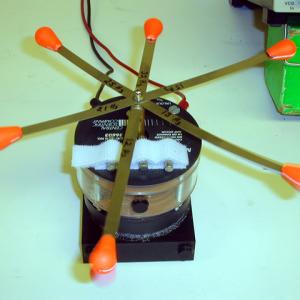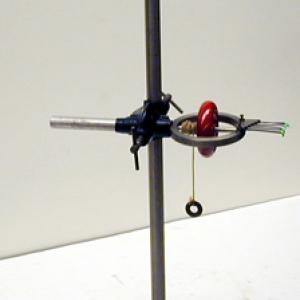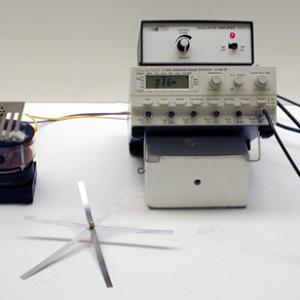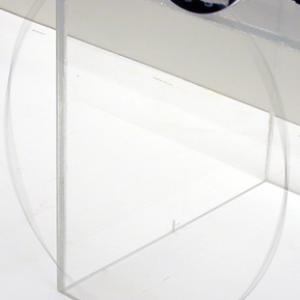College of Liberal Arts & Sciences
3A60.50 - Resonance Gyro - Frahm, Resonance Reeds, and Loops
Connect the reed sets to the mechanical oscillator.
CAUTION: Make sure the mechanical oscillator is locked when you are disconnecting the reeds or loops.
Then connect the wave generator to the amplifier and the amplifier to the oscillator. Set the reeds in vibration and as you sweep the frequencies different reeds will begin to resonate.
NOTE: Too much power at low frequencies will blow the fuses on the mechanical oscillator. Observe the same precautions when attaching and running the loop.
Pull the string of the resonance gyro really hard to set it in motion. As the unbalanced part of the gyroscope slows down the a appropriate length reed will vibrate.
Another demonstration of resonance is to place a quarter in a 9'' balloon. Blow the balloon up and tie it off. Move the balloon so the quarter starts to rotate very quickly on the inside. Stop moving the balloon and allow the quarter to slow down. A high pitched whine should be emitted when the coin is resonant to the natural period of the balloon.
- Jair Lúcio Prados Ribeiro, "Resonance in a Head Massager", TPT, Vol. 53, #4, Apr. 2015, p. 245.
- John A. Daffron and Thomas B. Greenslade Jr., "The Frahm Resonance Apparatus: Variations on a Theme", TPT, Vol. 51, #6, Sept. 2013, p. 357.
- Michael Liebl, "Saw Blades and Resonance", TPT, Vol. 43, # 3, May 2005, p. 282 - 284.
- Danning Bloom and Dan Bloom, "Vibrating Wire Loop and the Bohr Model", TPT Vol. 41, #5, May 2003, p. 292.
- Ronald Newburgh and G. Alexander Newburgh, "Finding the Equation for a Vibrating Car Antenna", TPT, Vol. 38, #1, Jan. 2000, p. 31.
- R. D. Edge, "Bags, Balloons, and Such", TPT, Vol. 30, #6, Sept. 1992, p. 379.
- Gordon C. McIntosh, "A Simple Resonance Demonstration", TPT, Vol. 28, #6, Sept. 1990, p. 417.
- Nathan Borowsky, "Mechanical Resonance Apparatus", TPT, Vol. 9, #3, Mar. 1971, p. 152.
- Thomas B. Greenslade Jr., "Frahm Resonance Top (Photo)", AJP, Vol. 76, #8, Aug. 2008, p. 787.
- Christopher C. Jones, "A Mechanical Resonance Apparatus for Undergraduate Laboratories", AJP, Vol. 63, #3, Mar. 1995, p. 232.
- R. Dean Ayers, "Mechanical Resonance of a Plastic Strip", AJP, Vol. 49, #3, Mar. 1981, p. 235.
- "W-155. Gong, Hat Stretcher & Goblet", DICK and RAE Physics Demo Notebook, 1993.
- "M-968. Hacksaw Blades & Plastic Beam", DICK and RAE Physics Demo Notebook, 1993.
- G. D. Freier and F. J. Anderson, "Mx-13", A Demonstration Handbook for Physics.
- Richard Manliffe Sutton, "S-15", Demonstration Experiments in Physics.
- Robert Ehrlich, "8.8. Resonant Rings", Why Toast Lands Jelly-Side Down, p. 129.
- Robert Ehrlich, "8.7. Resonant Vibrations of a Ruler", Why Toast Lands Jelly-Side Down, p. 128.
- Robert Ehrlich, "G.4. Resonance with a Slotted Tin Can", Turning the World Inside Out, p. 92 - 93.
- Ron Hipschman, "Resonant Rings", Exploratorium Cookbook II, p. 86.1 - 86.4.
- Raymond Bruman, "Resonator", Exploratorium Cookbook I, p. 63.1 - 63.6.
- "Resonant Rings", The Exploratorium Science Snackbook, 83-1.
Disclaimer: These demonstrations are provided only for illustrative use by persons affiliated with The University of Iowa and only under the direction of a trained instructor or physicist. The University of Iowa is not responsible for demonstrations performed by those using their own equipment or who choose to use this reference material for their own purpose. The demonstrations included here are within the public domain and can be found in materials contained in libraries, bookstores, and through electronic sources. Performing all or any portion of any of these demonstrations, with or without revisions not depicted here entails inherent risks. These risks include, without limitation, bodily injury (and possibly death), including risks to health that may be temporary or permanent and that may exacerbate a pre-existing medical condition; and property loss or damage. Anyone performing any part of these demonstrations, even with revisions, knowingly and voluntarily assumes all risks associated with them.




